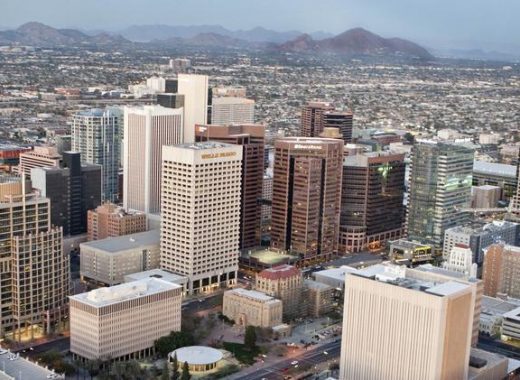Arizona Public Service Co. customers will see a $2 average increase on their bills in April and another $2 or so in November to cover the cost of natural gas to fuel power plants at the utility.
APS attributes the higher costs to the hottest summer on record in Arizona, which forced the company to buy more gas for its power plants as well as power from other utilities, and an increase in gas expenses it blamed on COVID-19.
The pandemic reduced oil production as people reduced driving, which reduced the availability of natural gas, a byproduct of oil drilling, according to the company’s explanations.
The line item for purchased power and natural gas is a fraction of a penny added to each kilowatt-hour of electricity customers use, so households that use more than the average will see larger increases, and the impact will be greater in summer than winter because people use more energy in warmer months.
Normally, the full $4 increase would have been added to customers’ bills automatically in February, but the Arizona Corporation Commission was concerned about the unexpected rate hike, so they intervened to minimize the hit to customers.
Utilities, however, are entitled to recover the money they spend running the power grid, so there was little the regulators could do to reduce the fee.
“I do not think this particular direction we are going is perfect, but at least it provides some relief for customers in the short term,” Chairwoman Lea Márquez Peterson said. “This is not the time to be having dramatic increases on customers, especially during a pandemic.”
Commissioners Justin Olson, a Republican, and Sandra Kennedy, a Democrat, opposed deferring the increase after APS officials explained that doing so could actually raise bills further because the utility eventually will recover the fuel expense and it could see additional debt expenses in the meantime, which customers also pay.
“It will add costs to ratepayers from the interest that will accrue,” Olson said.
The price that utilities pay for natural gas and the power they buy from other utilities is passed directly to customers with no markup. When utilities pay lower prices, rates drop. When costs go up, rates increase.
Previous commissions have set up a system where APS simply calculates its gas and power expenses, taking into account real prices from the past year and forecast prices for the year ahead, and adjusts prices up or down on Feb. 1 based on those calculations.
This year, the commission staff, recognizing the bump would be significant, pulled the item for special consideration by the five elected Corporation Commission members.
Newly elected commissioner Jim O’Connor, a Republican, requested the staff come up with alternatives to the automatic rate change, and one of those alternatives from the staff was to implement half the rate hike in April and the other half in November, delaying the full impact until after summer.
O’Connor and fellow Republican Márquez Peterson, as well as Democrat Anna Tovar, approved the plan where part of the hike would come in April and the rest in November, with likely more to come after that.
The increase about to hit customer bills doesn’t actually cover the total $222 million APS will collect from customers for higher gas prices, but the line item is capped on how much it can increase in a given year. So APS, which will be collecting only part of the balance, likely will seek another increase to take effect in February 2022 to collect the rest.
The recent cold snap in Texas, which shot natural gas prices up, reinforces the expectation that APS will seek another increase next year because the company spent about $39 million more than it budgeted to buy gas during that Texas freeze.
Much of the gas that APS anticipated getting from Texas at the time was not delivered, so the company had to buy on the spot market. Prices were significantly higher than the gas it had previously contracted to purchase, officials said.
APS delayed seasonal maintenance at a coal plant and at the Palo Verde Generating Station nuclear plant so that APS could use those plants rather than gas plants while prices were spiking because of the debacle in Texas, said Brad Albert, APS vice president of resource management.
“We took all the actions within the realm of possibility in order to limit the amount of natural gas exposure that we had,” Albert said.
Márquez Peterson asked Albert about APS selling power to California in summer 2020, including during days when Arizona utilities asked customers to voluntarily curtail home energy use if possible.
Albert explained that any power sales that were made to California when prices were high benefit Arizona ratepayers because they offset the company’s power expenses.
The record summer heat caused APS to spend about $64 million more than forecast on fuel and power, he said.
The commissioners also ordered an audit of the fuel costs at APS. The last one the commission has on record is from 2017.
Salt River Project, which divides the metro Phoenix area for electrical service with APS, also has seen its fuel and power costs increase and will raise rates on customers this year by about $4 a month.
SRP likewise recognized the significant bill impact. Officials decided earlier this year to mitigate that by contributing about $82 million from a separate fund to offset the fuel costs and to delay the bill increase until November.
APS and SRP actually reduced rates in 2019 based on the fuel and power prices they had been paying at the time.
APS also reduced the rate last year because the company didn’t predict the COVID-19 pandemic and record Arizona summer heat would send its gas expenses soaring in 2020.
The bill shock still is concerning to regulators, who appeared frustrated that prior commissions have allowed APS simply to adjust the gas line item without an opportunity for them to review and adjust it.
“Is the company relying too much on natural gas?” Kennedy asked.
Albert responded that he believes APS has a “balanced” portfolio of power resources.
“Your question, though, is exactly the type of question that ought to be debated in the integrated resources process,” Albert said.








